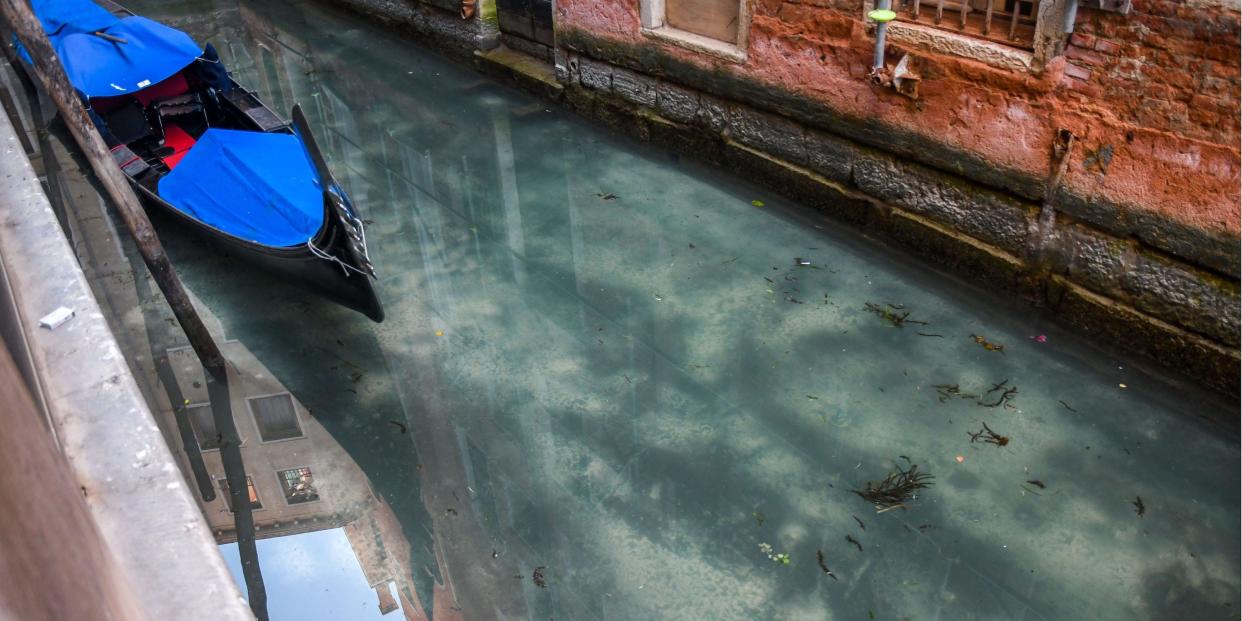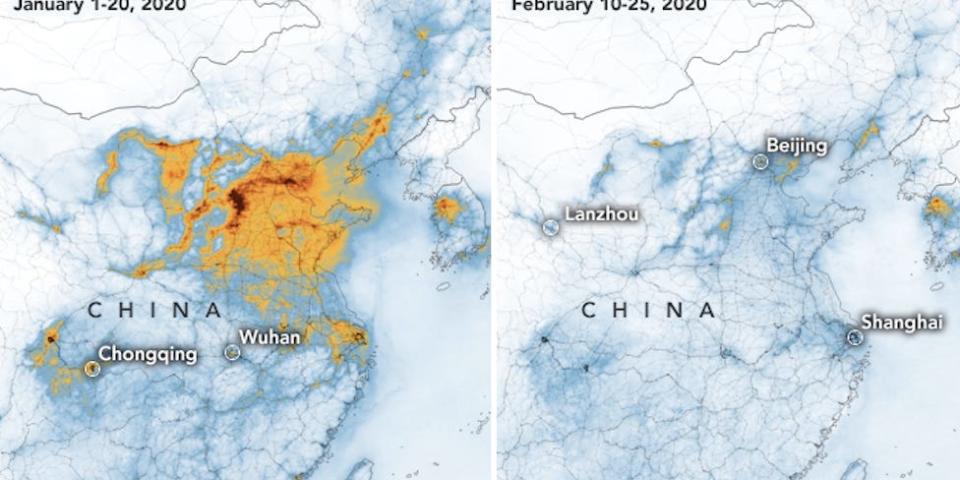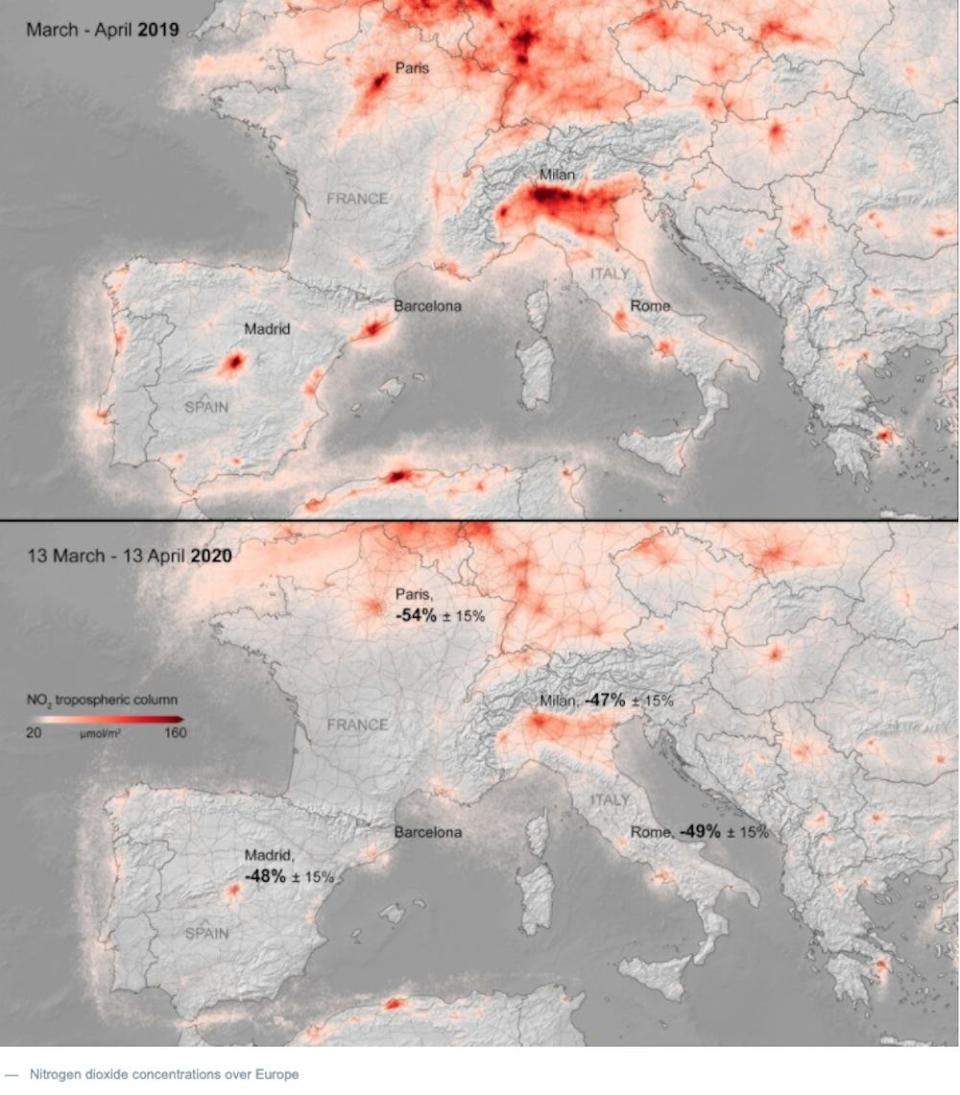Photos and charts show how the natural world is thriving now that humans are staying indoors

As the coronavirus continues to spread around the world, more than a third of the planet's population is under some form of lockdown, with many under order to stay at home and avoid social gatherings.
This lockdown has led to a profound impact on the global economy.
But fewer humans outside has also allowed the natural world to convalesce. Changes in pollution, air quality, and a resurgence of wildlife have all been observed in the months since the new coronavirus was first detected.
From cleaner beaches to less air pollution, here are 10 photos, videos, and charts that show how the world's condition is improving while humans stay indoors.
Related Video: How Long Will Social Distancing Last? It's Complicated
As the coronavirus pandemic continues to take hold of the world, many governments have imposed strict lockdown and social distancing measures in order to curb the spread of the disease. As of Wednesday evening, more than a third of the planet's population is under some form of restriction, with many under order to stay at home and avoid social gatherings.
Limiting social gathering has led to declines in certain industries, like travel and hospitality, which has stunted the global economy. But fewer humans outside has also allowed the natural world to convalesce. Changes to pollution, air quality, and a resurgence of wildlife have all been observed in the months since the new coronavirus was first detected in Wuhan, China, in December 2019.
Some environmentalists say that humans have put too much pressure on the natural world, leading diseases that typically exist in nature to spillover into humans.
"There are too many pressures at the same time on our natural systems and something has to give," Executive Director of the United Nations Environment Program told The Guardian last month. "We are intimately interconnected with nature, whether we like it or not. If we don't take care of nature, we can't take care of ourselves."
Other experts have said that the world is undergoing an "unprecedented natural experiment" in how restrictions on human activity put in place due to the new coronavirus have brought us clearer skies and cleaner air.
From cleaner beaches to less air pollution, here are 10 photos, videos, and charts that show how the world's condition is improving while people stay indoors.
Air pollution in China has decreased, and satellite photos have captured the dramatic drop in recent weeks.

The novel coronavirus originated in Wuhan, China, in December 2019, and began to spread to other parts of China and the world in the subsequent months.
Wuhan, in Hubei Province, introduced lockdown measures earlier than other cities, and by January 29 all cities in Hubei were under quarantine. But the virus spread quickly to other parts of mainland China, leading other Chinese cities to introduce curfews and other lockdown measures.
NASA and European Space Agency pollution monitoring satellites detected "significant decreases" in air pollution over parts of China in February compared to the month before.
While there is often a decline in air pollution around the Lunar New Year celebrations, NASA said this year there was more of a decrease than usual.
"This is the first time I have seen such a dramatic drop-off over such a wide area for a specific event," Fei Liu, an air quality researcher at NASA, said in the report.
"I am not surprised because many cities nationwide have taken measures to minimize spread of the virus," Liu added.
Still, some experts have warned that air pollution may bounce back as China begins to lift its lockdown restrictions and ramp up production to compensate for the previous losses.
Satellite photos also captured a drop in air pollution in Italy.

Italy has been one of the countries hardest-hit by COVID-19. Several provinces introduced lockdown measures in late February. A nationwide lockdown was put in place on March 9.
Data taken from the Copernicus Sentinel-5P satellite between January and March indicate a decline of air pollution, specifically nitrogen dioxide concentrations, over Italy.
According to the European Space Agency, the reduction in gases was particularly visible in northern Italy, which imposed lockdown measures in February, before the rest of the country followed.
Scientists said the pollution decrease was due to efforts to stop the coronavirus spread.
"Although there could be slight variations in the data due to cloud cover and changing weather, we are very confident that the reduction in concentrations that we can see, coincides with the lockdown in Italy causing less traffic and industrial activities," Claus Zehner, ESA's Copernicus Sentinel-5P mission manager, said in an April 13 report.
And major decreases in nitrogen dioxide concentrations were observed throughout Europe in recent weeks.

Data from the Copernicus Sentinel-5P satellite reported by the European Space Agency indicated that drops in nitrogen dioxide concentrations were observed across major European cities in recent weeks.
Nitrogen dioxide is a gas produced by power plants, cars, and other industrial facilities. It is found in the Earth's atmosphere and causes changes in weather patterns, as well as adverse health impacts on humans.
From March 13 to April 13, 2020, Madrid, Spain, Milan, Italy, and Rome, Italy, saw decreases of around 45% in their nitrogen dioxide concentrations from the year prior. Paris also saw a dramatic drop of 54% in those months, compared to the same frame in 2019.
Spain, Italy, and France all imposed coronavirus lockdown measures in recent weeks, which the European Space Agency says coincides with the drop in air pollution.
"Averaging data over longer periods of time allows us to see clearer changes in concentrations owing to human activity," Henk Eskes, from the Royal Netherlands Meteorological Institute, wrote in an April 16 report.
The Earth is rumbling less, and scientists may now be able to detect smaller earthquake aftershocks.
—Seismologie.be (@Seismologie_be) April 6, 2020
Data from the Royal Observatory of Belgium detected lower anthropogenic noise, or sounds produced by humans, since lockdown measures were put in place.
Since the lockdown measures were put in place, vibrations caused by human activity have fallen by about one-third, according to Nature.com, allowing the observatory's equipment to better detect waves with frequencies that would have been difficult to discern before the lockdown.
Andy Frassetto, a seismologist at the Incorporated Research Institutions for Seismology in Washington DC, told Nature.com that if lockdowns continue, detectors might be able to better pick up locations of earthquake aftershocks.
"You'll get a signal with less noise on top, allowing you to squeeze a little more information out of those events," Frassetto said.
In March, photos of emerged of the canals of Venice so clear that fish were visible under the surface.

In the weeks following the national lockdown, the canals of Venice saw a major improvement in water clarity. Photos taken last month show seaweed on the canals' bottoms, while photos of the nearby island of Burano show fish and swans in the water.
The office of Venice Mayor Luigi Brugnaro told CNN that the water looks clearer due to "less traffic on the canals, allowing the sediment to stay at the bottom."
Animals are returning to their habitats and other areas usually highly trafficked by humans. Bears have been spotted in greater frequency at Yosemite National Park in California since lockdown measures closed major tourist sites.
—Yosemite National Park (@YosemiteNPS) April 14, 2020
California has seen a growing number of coronavirus cases, and Gov. Gavin Newsom issued a mandatory statewide stay-at-home order on March 19.
Around 95% of Yosemite National Park is designated wilderness. The park also sees about 4 million visitors each year, particularly at the start of springtime when bears come out of hibernations, which makes it difficult for the bears to forage for food.
But since the park closed to visitors on March 20, the park's 300 to 500 black bears have been spotted "more frequently than usual," the park tweeted on April 14. Bobcats have also been spotted in empty administrative buildings, and coyotes have been able to pass through quiet roads and walkways without human distraction, according to the LA Times.
"The bear population has quadrupled," Dane Peterson, a park employee, told The Times.
Wild mountain goats returned to the small town of Llandudno, Wales.

On March 31, the small town of Llandudno was overrun by Great Orme goats, which were initially brought to the area in the 19th century to create a cashmere wool industry.
The goats usually roam the hillsides overlooking the town and rarely venture into the street. But as humans were stuck in their homes, the goats entered into the town to trim hedges and see the sights before returning to the hillside.
In India, the Himalayas were visible for the first time in decades.
—Saanu Ki 😬 (@Deewalia) April 3, 2020
On March 24, India imposed a nationwide lockdown for 21 days in order to curb the spread of coronavirus within its borders.
Residents in the northern Indian state of Punjab say they that in recent weeks, the lack of man-made air pollution has allowed them to see the Himalayas for the first time in decades.
While it is unclear exactly when the region last saw the Himalayas, residents have said it had been at least three decades.
One theory is that the coronavirus might have originated in live animals and transferred to people at a "wet market." China has temporarily banned the trade and consumption of wild animals in response.
—Muyi Xiao (@muyixiao) January 21, 2020
After discovering that coronavirus infections were first reported from the vicinity of a "wet market," or a place that traditionally sells dead and live animals along with other produce and goods for consumption, China banned the trade of live animals at food markets.
The Huanan Seafood Market in Wuhan was shuttered on January 1. But before its closure, the market was selling an array of unusual animals for food, including young wolves and civet cats, which experts believe could play a part in the spread of disease.
On February 24, China comprehensively prohibited the trade trafficking and consumption of wildlife. The industry is valued at $7.1 billion and employs 1 million people, Nature.com reported.
There have also been heightened calls to ban wet markets overall, as they increase the risk of disease spread.
And without humans, typically busy beaches have become cleaner and the water clearer.
—Louis Aguirre (@LOUISAGUIRRE) April 5, 2020
Beaches and other heavily visited areas have reportedly become less polluted.
Louis Aguirre, a news anchor at WPLG Local 10 News Miami, posted photos of Miami beaches showing empty beaches. He said that the color and clarity of the water "dazzled."
"It legit took my breath away," he wrote on Twitter.
Other residents in Florida reported that since local authorities issued orders to close beaches last month, the waters have become clearer.
Mike Ruiz told WPLG that waters had become clearer than he had ever observed while filming marketing videos in the area.
"I felt like I was in a movie," Ruiz said. "The ocean was crystal clear, neon blue; you could see right through the bottom of the ocean. I've never seen the water that blue in the years that we've been filming in South Florida."
Seth Bloomgarden, chairman of the Miami Surfrider Foundation, told WPLG that while volunteers have not been able to test the water quality to verify whether they have become cleaner under lockdown, he is confident that the coronavirus lockdown has had a profound impact on the environment.
"I think the universe has given us an opportunity to hit the pause button, and see all the harm that we've actually been doing to the environment and how to get it right," Bloomgarden told WPLG.
Read the original article on Insider

